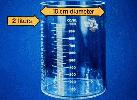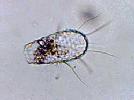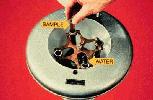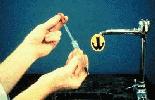Troubleshooting Tests...
The operator must determine the probable cause and select one or more of the corrective measures to restore the process to
full efficiency with the least adverse effect on the final effluent quality and at the lowest cost. To do this, the operator
needs a thorough knowledge of the plant's activated sludge process and how it fits into the overall plant operation.
Mixed Liquor Settleability Test : This section refers frequently to the mixed liquor settleability test and
a settleometer, a specially marked wide - mouth beaker, for observing how sludge settles. Some operators use a 1 - L
graduated cylinder instead of the settleometer for this test, but the sidewall effects of the narrow cylinder interfere
with the settling. This test, which shows the mixed liquor settling characteristics under controlled conditions, is one
of the most useful tools for understanding what is happening to the process. When performing the test, observe the floc
in the settleometer to determine if it is granular with well - defined edges and interspaces.
 "Settleometer"...
"Settleometer"...













 "Settleability Test"...
"Settleability Test"...
Microscopic Examination : By examining the mixed liquor with a microscope, much can be determined about the
activated sludge process. The presence of various microorganisms within the mixed liquor floc can quickly indicate good or poor
treatment. The operator or technician needs only to recognize major groups organisms such as ; (1) Protozoa including
amoebas, flagellates, ciliates (free swimming or stalked), (2) Rotifers and (3) Filamentous bacteria. Also, the microscope
can be used to observe other important characteristics such as the relative abundance of filaments, floc characteristics,
and supernatant characteristics.






Sludge Blanket Level : The sludge blanket level measurement offers an important operational and troubleshooting
tool. By making multiple measurements across clarifiers (profiles), currents may be detected. By trend charting average
values along with other data, overall plant performance can be evaluated and related to sludge blanket depth.
Mixed Liquor Respiration Rate : The mixed liquor respiration rate, also referred to as the Specific Oxygen
Uptake Rate (SOUR), indicates the biological activity in the activated sludge process; the rate changes under different
conditions.
Nitrification Rate : The nitrification rate indicates the activity of the nitrifiers in a nitrifying process.
Ammonia Profile : An ammonia profile of a nitrifying process, made with a probe, will provide essential data
on the process.



Troubleshooting by Settling Test...
 Slow settling in test...
Slow settling in test...
 "Settleability Test for Bulking Sludge"...
"Settleability Test for Bulking Sludge"...
Perform microscopic examination...
- Very few or no filaments, dispersed floc, supernatant turbid or cloudy
- Check for toxics and low specific oxygen uptake rate
- Enforce sewer use ordinance
- Check for high F:M bulking and MLVSS, SRT, F:M and influent BOD changes
- Switch to contact stabilization, if possible
- Decrease wasting, put another aeration tank on-line if necessary
- Decrease return rate
- Use settling aid, if possible
- Very few or no filaments, dispersed floc, supernatant clear but clarifier effluent cloudy
- Check for high F:M bulking and MLVSS, SRT, F:M and influent BOD changes
- Switch to contact stabilization, if possible
- Decrease wasting, put another aeration tank on-line if necessary
- Decrease return rate
- Use settling aid, if possible
- Very few or no filaments, dispersed floc, supernatant clear
- Check for high MLSS, low F:M and old, thick sludge causing hindered settling (not bulking)
- Conduct dilution test, if dilution improves settleability, increase wasting to raise F:M
- Moderate to large number of filaments, (try to ID filaments involved and determine if they are bacteria or fungi),
supernatant very clear
- Chlorinate RAS at 1 - 10 kg/1,000 kg MLVSS.day, starting low, check frequency of exposure
- Monitor settleability, monitor effluent turbidity, and observe filaments with microscope, correct underlying cause
of bulking
- Check available N, P, and Fe for nutrient deficiency
- If BOD:N > 100:3, try adding N
- If BOD:P > 100:1, try adding P
- If BOD:Fe > 100:0.5, try adding Fe
- Check for too low DO for F:M or specific oxygen uptake rate
- If DO too low, increase aeration
- If DO uneven;
(a) Clean diffusers
(b) Increase aerator speed or raise weir
(c) Change to step feed, complete-mix or tapered aeration, if possible
- Decrease F:M, if possible
- Add a settling aid
- Use upstream attached growth process, if possible
- Check pH for wide fluctuations or low value
- Chlorinate RAS (see above)
- If influent pH < 6.5, identify source and correct or try raising pH
- If widely varying, control at source
- If process is nitrifying unnecessarily, increase wasting, if nitrification is required, raise and maintain constant pH
- Check influent wastewater and in-plant side-streams for filaments
- Chlorinate influent at 5 - 10 mg/L
- Pre-aerate upstream, if possible
- Optimize performance of or upgrade in-plant processes
- Check for insufficient soluble BOD gradient causing low F:M bulking
- Consider using a selector or switching to plug-flow
- Increase F:M
- Decrease aeration tankage on-line
- Check for high F:M bulking
- Switch to contact stabilization, if possible
- Decrease wasting, put another aeration tank on-line, if necessary
- Check for septic wastewater with sulphides
- Add an oxidizing agent
- Pre-aerate upstream, if possible
Centrifuge Test...
The primary purpose of the centrifuge test is to obtain a quick, reliable estimation of the suspended solids concentration
of the mixed liquor in the aeration basin, return sludge from the final clarifier, and waste sludge from the activated
sludge system. In addition, the centrifuge test can be used to estimate the suspended solids concentration of the sludge
from the primary clarifier, digestor, or any area within the treatment facility. For this quick reference section, the
procedure for conducting the centrifuge test, which, again, is used to estimate the suspended solids concentration of the
mixed liquor in the aeration tank (aeration tank concentration or ATC, the return sludge concentration, or RSC, and waste
sludge concentration, or WSC), will be outlined. Modification of the procedure can be made when estimates of the suspended
solids concentration of the sludge from the primary clarifier, digestor, etc., are desired.




Equipment Needed...
(1) Laboratory - centrifuge : The type of centrifuge that is used is very important to ensure reliable data. The
speed (or rpm) of the centrifuge listed in the first part of this manual has proven to be fast enough to give the desired
consistent results. It is important to use a centrifuge that spins at high speeds in order to get consistent results from
the centrifuge spin. In addition to spinning at high speeds, the test tube holder that comes with the centrifuge (in other
words, the centrifuge head that is placed on the centrifuge) should spin the test tubes horizontally and not at a 45o
or some other angles. If the test tubes spin at an angle, then the solids are packed at an angle, making the reading
difficult to interpret.
(2) Balance : Balance, of a capacity and accuracy appropriate to the size of specimen to be tested. An automatic
top - pan reading to 0.01 grams is suitable.
(3) Sample collector : An appropriate sample collector, which may consist of a quart plastic or glass jar attached
to a long pole.
Procedure...
(1) Collecting sample : The centrifuge test tubes generally pnly hold from 10 to 15 mL each ; however, it is advisable
to collect at least 100 mL of well - mixed sample for the centrifuge spin. For the centrifuge test, the aeration tank
concentration (ATC) sample should be collected at the end of each aeration basin. The return sludge concentration (RSC)
sample should be collected at the point where the return sludge is discharged to the aeration basin or incoming plant
channel. If the sludge is returned to separate aeration basins through a common header line, then only one RSC sample is
necessary. If sludge is returned to separate aeration basins through separate lines, then separate RSC samples should be
collectcd when wasting begins, when wasting ends, and periodically during wasting especially if wasting continues for an
extended period of time. Often the sludge wasted from the activated sludge system is the return sludge. In this case the
RSC sample becomes the WSC sample. The test tubes used for the centrifuge test are generally 15 mL test tubes graduated in
percent reading, with the full mark representing 100 percent. Before pouring the sample into the test tubes, ensure that the
test tubes are clean. The test results will be inaccurate if any water or solids are left in the test tubes from previous
tests.


(2) Mixing sample : The sample which is to be poured into the test tubes should be well - mixed (i.e., thoroughly
shaken up or stirred up) before being poured into the test tubes.
(3) Rinsing tubes : Rinse test tube with sample by filling the test tube about half full, swirling the sample around,
and dumping the contents of the test tube in the sink.





(4) Pour sample into the test tubes : After rinsing the test tubes, fill with sample so that the bottom of the
meniscus is on the 100 percent mark of the test tubes.
(5) Clean outside of the test tubes : After each test tube is filled with sample to the 100 percent mark, wipe the
excess water from the outside of the test tube. If the outside of the tube is wet when placed in the centrifuge test tube
holder, then the test tube will sometimes break more easily when spun in the centrifuge. In addition to keeping the outside
of the test tube itself dry, it is important to keep the test tube holder and rubber stopper located at the bottom of the
test tube holder dry. Periodically inspect the test tube holder and rubber stopper to ensure that they are dry, and inspect
the rubber stopper to ensure that it does not have a hole punched through it. If the rubber stopper does have a hole punched
through it, the test tube may break when spun in the centrifuge. It is advisable to replace any rubber stoppers that have
holes in them.



(6) Place test tubes in holders : The centrifuge hcad generally has six separate test tube holding chambers, making
this centrifuge - centrifuge head combination capable of running six separate solids tests at one time. Frequently, however,
an operator needs to run routinely only 2, 3, or 4 samples (i.e., one ATC and one RSC, two ATC's and one RSC, or two ATC's
and two RSC's). For these routine tests, the operator should select a specific procedure for placing the tubes containing
these samples into the test tube holders and follow this procedure routinely. For example, if 3 samples are spun, place the
one ATC sample in the #1 test tube holder, the second ATC sample in the #2 test tube holder, and the RSC sample in the #3
test tube holder. Now ensure that the centrifuge is balanced (i.e., have test tubes with water or sample that weigh nearly
the same as your samples) directly across from each sample tube. If the centrifuge is not balanced, it will shake severely
break test tubes and shorten the life expectancy of the centrifuge itself.
It is also suggested that a test tube filled with water be placed in each of the test tube holders that do not have test
tubes in them containing samples. Thus, if you run only one sample, then fill five more tubes with water, ensure they all
weigh approximately the same, and place these tubes in the remaining five test tube holders. The purpose of always having six
test tubes filled with either sample or water in each of the six tube holders is twofold ; (a) it establishes a routine,
and (b) it ensures that the centrifuge spins at nearly the same speed regardless of the number of samples that are run. If
the centrifuge spins faster during one testing period, then the test tube reading will be less than it would have been it
the centrifuge spun slower, thus causing an error in the interpretation of the test results from one testing period to the
other.
(7) Spin at highest speed for 15 minutes : After placing the test tubes filled with sample into the appropriate
test tube holders and the test tubes filled with water in the remaining test tube holders, you are now ready to spin the
centrifuge test tube holder. As mentioned earlier, the speed of the centrifuge is an important factor in obtaining consistent
data. Since high speeds are necessary, the centrifuge is spun at the highest speed (or #7 speed setting).
Another important factor in obtaining consistent test data is the length of time the centrifuge is spun. This time period
should be long enough to give consistent test data, yet short enough to give quick test results. It has been shown that a
time period of 15 minutes satisfies both these requirements. Therefore, spin the centrifuge at the highest speed for 15
minutes. Other types of centrifuges may be spun at different speed settings, but the use of the 15-minute time period is
for any settings. It is further suggested that an automatic timer be used in conjunction with the centrifuge so that the
centrifuge will automatically shut off after 15 minutes. By connecting the centrifuge to the timer, you may leave the area
temporarily and return later to read the test tubes. In addition, the connection ensures that all spins will be 15 minutes
and errors due to longer or shorter spins will be reduced or eliminated.
(8) Read and record the solids level in percent : After the test tubes spin in the centrifuge at the highest speed
setting for the 15 minutes, you are ready to read the test results and record the data for additional calculations.






(9) Cleaning of the test tubes after centrifugation : The centrifuge test tubes are difficult to clean because of
the impacted solids concentrated at the bottom of the tubes. These tubes must be thoroughly cleaned before they are used
again or inaccurate test results will occur. There are many methods that can be used to wash the test tubes ; however, one
method that has proven very efficient requires soapywater, rinse water, a pipette (ideally a 10 mL graduated type), a
suction bulb, and a small brush (a common 10 mm test tube brush is adequate). The procedure for cleaning a test tube is as
follows ; place the suction bulb on the end of the pipette and draw soapy water through the pipette into the suction bulb.
Put the end of the pipette into the test tube just above the packed solids and squeeze the suction bulb, forcing soapy
water through the pipette into the packed solids to loosen the solids (warm soapy water is most effective against solids
that contain grease and oils). The solids that stick to the side of the test tube can he loosened with the small brush and
soapy water. All loosened solids and soap can then be rinsed away with tap water.

Calculations...
Equation...
Percent solids = ( 100 ) ( mL of sludge solids / total volume in mL of sample in the centrifuge tube )
Example...
Total volume in the centrifuge tube = 15.0 mL
Volume of settled solids after centrifuging for 15 minutes = 4.6 mL
Percent solids = ( 100 ) ( 15.0 / 4.6 ) = 3.3 %
Data Recording...
|
Activated sludge - centrifuge test benchsheet
|
|
Date : ____________ Time : ____________ Analyst : ____________
|
|
Sample location : _________________________________________
|
|
Sample characteristics : ___________________________________
|
Notes : The purpose of the centrifuge test is to obtain a quick, reliable estimation of the suspended solids level
in the mixed liquor in the aeration basin, in the return sludge from the final clarifier, and in the waste sludge from the
activated sludge process itself. These data then can be applied to modification of the overall process to obtain maximum
treatment efficiency. The aeration tank concentration sample should be collected at the end of each aeration basin. The
return sludge concentration sample should be collected at the point where the return sludge is discharged to the aeration
basin or incoming plant channel. The waste sludge concentration sample should be collected when wasting begins, when
wasting ends, and periodically during wasting, especially if wasting continues for an extended period of time. Often the
sludge wasted from the activated sludge system is the return sludge, in this case, the RSC sample becomes the Waste Sludge
Concentration (WSC) sample. Solids are generally reported as percentage as given in the above equation.
| ( 1 ) |
( 2 ) |
( 3 ) |
( 4 ) |
| Sludge source |
Depth in mm of entire sample in centrifuge tube |
Depth in mm of solids after centrifugation |
Percent solids [ ( 100 ) ( 3 / 2 ) ] |
| ATC |
________________________________________ |
__________________________________ |
________________________ |
| RSC |
________________________________________ |
__________________________________ |
________________________ |
| WSC |
________________________________________ |
__________________________________ |
________________________ |



 "Settleometer"...
"Settleometer"...
 "Settleometer"...
"Settleometer"...













 "Settleability Test"...
"Settleability Test"...










 "Settleability Test for Bulking Sludge"...
"Settleability Test for Bulking Sludge"...























